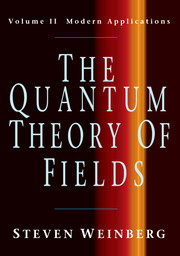Book contents
- Frontmatter
- Contents
- PREFACE TO VOLUME II
- NOTATION
- 15 NON-ABELIAN GAUGE THEORIES
- 16 EXTERNAL FIELD METHODS
- 17 RENORMALIZATION OF GAUGE THEORIES
- 18 RENORMALIZATION GROUP METHODS
- 19 SPONTANEOUSLY BROKEN GLOBAL SYMMETRIES
- 20 OPERATOR PRODUCT EXPANSIONS
- 21 SPONTANEOUSLY BROKEN GAUGE SYMMETRIES
- 22 ANOMALIES
- 23 EXTENDED FIELD CONFIGURATIONS
- AUTHOR INDEX
- SUBJECT INDEX
15 - NON-ABELIAN GAUGE THEORIES
Published online by Cambridge University Press: 05 May 2013
- Frontmatter
- Contents
- PREFACE TO VOLUME II
- NOTATION
- 15 NON-ABELIAN GAUGE THEORIES
- 16 EXTERNAL FIELD METHODS
- 17 RENORMALIZATION OF GAUGE THEORIES
- 18 RENORMALIZATION GROUP METHODS
- 19 SPONTANEOUSLY BROKEN GLOBAL SYMMETRIES
- 20 OPERATOR PRODUCT EXPANSIONS
- 21 SPONTANEOUSLY BROKEN GAUGE SYMMETRIES
- 22 ANOMALIES
- 23 EXTENDED FIELD CONFIGURATIONS
- AUTHOR INDEX
- SUBJECT INDEX
Summary
The quantum field theories that have proved successful in describing the real world are all non-Abelian gauge theories, theories based on principles of gauge invariance more general than the simple U(1) gauge invariance of quantum electrodynamics. These theories share with electrodynamics the attractive feature, outlined at the end of Section 8.1, that the existence and some of the properties of the gauge fields follow from a principle of invariance under local gauge transformations. In electrodynamics, fields ψn(x) of charge en undergo the gauge transformation ψn(x) → exp(ienΛ(x))ψn(x) with arbitrary Λ(x). Since ∂μψn(x) does not transform like ψn(x), we must introduce a field Aμ(x) with the gauge transformation property Aμ(x) → Aμ(x)+∂μΛ(x), and use it to construct a gauge-covariant derivative ∂μψn(x)–ienAμ(x)ψn(x), which transforms just like ψn(x) and can therefore be used with ψn(x) to construct a gauge-invariant Lagrangian. In a similar way, the existence and some of the properties of the gravitational field gμn(x) in general relativity follow from a symmetry principle, under general coordinate transformations. Given these distinguished precedents, it was natural that local gauge invariance should be extended to invariance under local non-Abelian gauge transformations.
In the original 1954 work of Yang and Mills, the non-Abelian gauge group was taken to be the SU(2) group of isotopic spin rotations, and the vector fields analogous to the photon field were interpreted as the fields of strongly-interacting vector mesons of isotopic spin unity.
- Type
- Chapter
- Information
- The Quantum Theory of Fields , pp. 1 - 62Publisher: Cambridge University PressPrint publication year: 1996
- 1
- Cited by



